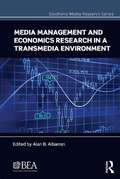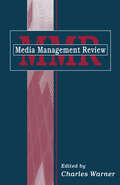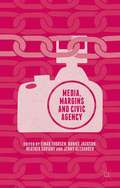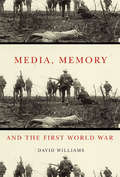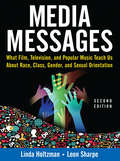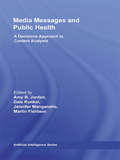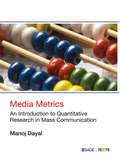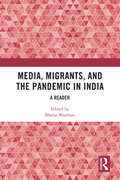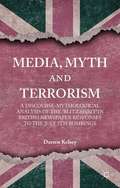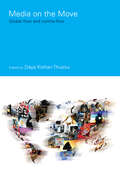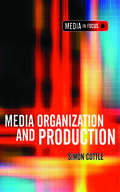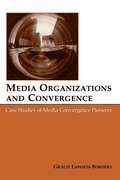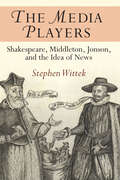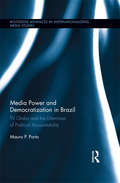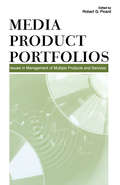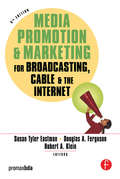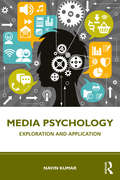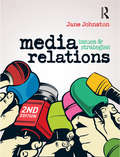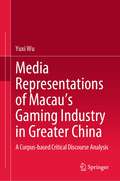- Table View
- List View
Media Management: A Casebook Approach
by George Sylvie C. Ann Hollifield Leblanc Jan Wicks Stephen Lacy Broadrick Ardyth SohnMedia Management: A Casebook Approach provides a detailed look at the major areas of responsibility that fall to the managers of media organizations, including leadership, motivation, planning, marketing, and strategic management. It provides media-based cases that promote the development of critical thinking and problem-solving skills. Addressing such topics as diversity, group cultures, progressive discipline, training, and market-driven journalism, this casebook provides real-world scenarios that help students anticipate and prepare for experiences in their future careers. Among the additions to this fourth edition are Increased discussions on groups, vision, change, diversity, and management styles; Additional media-sensitive examples within each section of the text; A new chapter on knowledge management; Ethics integrated into law and leadership discussions; A primer in global markets, technology, and policy; In-depth consideration into the aspects of change; and Increased emphasis on analysis. This edition also includes management scenarios in which one or more participant is a new employee or intern, making the material relevant to students while also preparing them to understand the motivations of their future employers. Developed as a media management text for advanced undergraduates and graduate students, Media Management provides realistic scenarios and invaluable insights on working in the media industries.
Media Management and Economics Research in a Transmedia Environment (Electronic Media Research Series)
by Alan B. AlbarranThis landmark work centers on media management and economics within a diverse, international, historical and constantly changing environment. The chapters herein reflect the current state of research and present directions for future study. Developed at the 2012 Research Symposium in conjunction with the annual convention of the Broadcast Education Association, it represents the most current theory and research in the area.
Media Management Review
by Charles WarnerThis unique publication deals exclusively with current media management issues. It fills a void in the current literature and provides an outlet for a growing number of media scholars and practitioners interested in the ever-changing and ever-more-complex field of media management. The Media Management Review was designed to appeal to working professionals who deal directly with managing the media: radio, television, cable, newspapers, magazines, new media, and advertising agencies. Written in a style that is both understandable and applicable, this annual volume is an indispensable resource filled with information on the latest media management theories and practices.
Media, Margins and Civic Agency
by Daniel Jackson Jenny Alexander Heather Savigny Einar ThorsenThis collection brings together new research on contemporary media, politics and power. It explores ways and means through which media can and do empower or dis-empower citizens at the margins that is, how they act as vehicles of, or obstacles to, civic agency and social change.
Media, Memory, and the First World War
by David WilliamsOf interest to historians, classicists, media and digital theorists, literary scholars, museologists, and archivists, Media, Memory, and the First World War is a comparative study that shows how the dominant mode of communication in a popular culture - from oral traditions to digital media - shapes the structure of memory within that culture.
Media, Memory, and the First World War (McGill-Queen's Studies in the History of Ideas #107)
by David WilliamsOf interest to historians, classicists, media and digital theorists, literary scholars, museologists, and archivists, Media, Memory, and the First World War is a comparative study that shows how the dominant mode of communication in a popular culture - from oral traditions to digital media - shapes the structure of memory within that culture.
Media Messages: What Film, Television, and Popular Music Teach Us About Race, Class, Gender, and Sexual Orientation
by Linda Holtzman Leon SharpeThe new edition of this widely adopted book reveals how the popular media contribute to widespread myths and misunderstanding about cultural diversity. While focused on the impact of television, feature film, and popular music, the authors reach far beyond media to explore how our understanding, values, and beliefs about race, class, gender and sexual orientation are constructed. They analyze how personal histories, combined with the collective history of oppression and liberation, contribute to stereotypes and misinformation, as well as how personal engagement with media can impact prospects for individual and social freedom. Along with updated media examples, expanded theories and analysis, this edition explores even more deeply the coverage of race in two chapters, discusses more broadly how men and boys are depicted in the media and socialized, and how class issues have become even more visible since the Great Recession of the 21st century and the Occupy movements. Special activities and exercises are provided in the book and an online Instructor's Manual is available to adopters.
Media Messages and Public Health: A Decisions Approach to Content Analysis
by Amy B. Jordan Dale Kunkel Jennifer Manganello Martin FishbeinMedia Messages and Public Health addresses the full range of methodological and conceptual issues involved in content analysis research, specifically focused on public health-related messages and behaviors. Uniquely tailored to the challenges faced by content researchers interested in the study of public health topics, coverage includes: Conceptual and methodological foundations involved in the practice of content analysis research used to examine public health issues. Measurement challenges posed by the broad range of media. Use of content analysis across multiple media types. The potential for individual differences in audience interpretation of message content. Case studies that examine public health issues in the media to illustration the decisions that are made when developing content analysis studies. The volume concludes with a set of guidelines for optimal content analysis research, and suggests ways in which the field can accommodate new technologies and new ways of using media. Developed for researchers in communication, media, and public health, this unique resource demonstrates how the variety of decisions researchers make along the way allows the exploration of traditions, assumptions and implications for each varying alternative and ultimately advances the science of content analysis research.
Media Metrics: An Introduction to Quantitative Research in Mass Communication
by Manoj DayalThe book is a comprehensive introduction to the application of statistical tools and techniques in media research. "Media metrics" is the use of statistics and mathematics in media research. This book largely explains scientific methods of data collection and analysis to achieve useful results from quantitative media data. It effectively describes the crucial relationship between key media forces such as print and electronic media, corporate communication and public relations, advertising, development communication, web and traditional media, and so on. It guides the readers to understanding the challenges of media measurement, its quantification, datafication and assessment, and helps in developing skills of media audience analysis. Key Features Pioneering introductory text on media metrics, a method of measuring media variables Clear and easy-to-understand explanation of descriptive and inferential media variables and their use Complete coverage with relevant examples from media studies Review exercises, and extensive list of references Ideal companion for students and researchers in the fields of mass communication, media studies, communication studies, and journalism
Media, Migrants and the Pandemic in India: A Reader
by Bharat BhushanThe national lockdown to contain the COVID-19 pandemic in India resulted in the loss of work and displacement of thousands of urban migrant workers. This book records the arduous journey home for many of these workers and analyses the grave effects the pandemic has had on jobs, livelihoods, and the health of urban migrant workers. A rich compilation of deep analytical articles by journalists, academics, lawyers, and social activists, this book explores various facets of the crisis as it unfolded. It examines the welfare policies of state and central governments and discusses the role of the judiciary and the public policy response to the unemployment, health risks, and mass migration of workers. It also offers readers a better understanding of the complexities of the migrant crisis, how it unfolded, and how it was addressed by the media. This timely and prescient book will be of great interest to the general reader as well as researchers and students of media studies, journalism, sociology, law, public policy, labour and economics, welfare economics, gender studies, and development studies.
Media, Myth and Terrorism
by Darren KelseyMedia, Myth and Terrorism provides a rigorous case study of Blitz mythology in British newspaper responses to the July 7th bombings. Considering how the press, politicians and members of the public were caught up in popular accounts of Britain's past, Kelsey explores the ideological battleground that took place in the weeks following the bombings as the myth of the Blitz was invoked. By providing conceptual discussions of myth, discourse, and ideology, Kelsey proposes a discourse-mythological framework designed for analysing discursive constructions of mythology. In doing so, this research considers multiple recontextualisations of the Blitz myth when popular memories of 1940 recurred in 2005. Kelsey encourages readers to understand the politics of remembering by showing how popular yet inaccurate stories from the past have a significant impact on our perceptions of the present. Heroism, trauma, economics, Royalty, rituals, human rights, foreign policy, immigration and multiculturalism are just some of the topics covered across a vast landscape of stories embracing a myth from the past in order to understand the present.
Media on the Move: Global Flow and Contra-Flow (Communication and Society)
by Daya Kishan ThussuMedia on the Move provides a critical analysis of the dynamics of the international flow of images and ideas. This comes at a time when the political, economic and technological contexts within which media organisations operate are becoming increasingly global. The surge in transnational traffic in media products has primarily benefited the major corporations such as Disney, AOL, Time Warner and News Corporation. However, as this book argues, new networks have emerged which buck this trend: Brazilian TV is watched in China, Indian films have a huge following in the Arab world and Al Jazeera has become a household name in the West. Combining a theoretical perspective on contra-flow of media with grounded case studies into one up-to-date and accessible volume, Media on the Move provides a much-needed guide to the globalization of media, going beyond the standard Anglo-American view of this evolving phenomenon.
Media Organization and Production (The Media in Focus series)
by Simon CottleDrawing on the work of international contributors Media Organization and Production examines a wide range of global-local media organizations and the production of different mediums and genres. Following the editor's introduction which sets out the principal differences of approach and defining debates, chapters address: transnational and national, commercial and public service corporations; international film and TV co-productions; children's television news production, the historical development of 'liveness' on radio, and music journalism; the politics and organizational forms of alternative media production including radical newspapers, video and the internet; and the changing 'production ecology' of natural history television. These topics are examined through a variety of theoretical and conceptual frameworks that help to illuminate how cultural production often involves a complex articulation of differing influences and constraints, both material and discursive, intended and unintended, structurally determined and culturally mediated.Together the chapters in this book help to recover this complexity and thereby help us to better understand the nature and output of today's media.
Media Organizations and Convergence: Case Studies of Media Convergence Pioneers (Routledge Communication Series)
by Gracie L. Lawson-BordersThis volume offers a timely examination of technology's impact on media companies and the results of convergence among media industries, considering the effects on journalistic, business, and economic practices. Media Organizations and Convergence: Case Studies of Media Convergence Pioneers considers the many definitions of convergence and explores the changes in communication technologies. Author Gracie L. Lawson-Borders provides a brief history of media segments and their evolutions as they adapt to emerging technologies, media conglomeration, and the competitive and global changes that have occurred in the industry. She also examines the theoretical implications of technology and convergence in the operations and practices of media organizations.The case studies included here profile three media convergence pioneers--Tribune Company in Chicago, Media General in Richmond, and Belo Corporation in Dallas--that have incorporated convergence into their journalistic practices. Lawson-Borders considers the social, cultural, and political implications of convergence, and presents issues and concerns for the future of convergence in the media industry.As a snapshot of media convergence at the current stage in its evolution, this book offers important insights into the business of media at a time of dramatic change. It will be a valuable resource for scholars and students in media management, mass media, and related areas of the media industry.
The Media Players
by Stephen WittekThe Media Players: Shakespeare, Middleton, Jonson, and the Idea of News builds a case for the central, formative function of Shakespeare's theater in the news culture of early modern England. In an analysis that combines historical research with recent developments in public sphere theory, Dr. Stephen Wittek argues that the unique discursive space created by commercial theater helped to foster the conceptual framework that made news possible. Dr. Wittek's analysis focuses on the years between 1590 and 1630, an era of extraordinary advances in English news culture that begins with the first instance of serialized news in England and ends with the emergence of news as a regular, permanent fixture of the marketplace. Notably, this period of expansion in news culture coincided with a correspondingly extraordinary era of theatrical production and innovation, an era that marks the beginning of commercial theater in London, and has left us with the plays of William Shakespeare, Ben Jonson, and Thomas Middleton. Book jacket.
Media Pluralism in the Digital Era: Legal, Economic, Social, and Political Lessons Learnt from Europe
by Elda BrogiBringing together scholars, journalists, and researchers from 27 European countries, this book provides a comparative and longitudinal analysis of the evolution of conditions and standards relevant for sustainable, free, and plural media and journalism in Europe in the last ten years.Approaching the challenging and ever-changing concept of media pluralism from various complementary and sometimes conflicting angles, combining legal, economic, social, and political perspectives, chapters provide a holistic account of the concept of media pluralism, a key condition for a well-functioning democracy. This book draws on data from the Media Pluralism Monitor project, a scientific tool designed and implemented on a regular basis to document the health of media ecosystems, to provide insights into central dimensions of media systems across the EU and candidate countries. These include: the fundamental protection of freedom of expression and safety of journalists and the independence of media authorities; market plurality, transparency of ownership, media concentration, media viability, competition enforcement, and digital platforms’ dominance; disinformation, media literacy, and digital challenges; political independence, conflicts of interest, editorial autonomy, and the independence of public service media; social inclusiveness, including access to media and representation of women and community media. Offering a comprehensive overview of key areas of EU media policy, causes and solutions for the media economic struggle, and innovative examples of business models for journalism in the digital age, this book is recommended reading for advanced students and researchers of media policy and regulation, as well as policymakers.
Media Politics: A Citizen's Guide
by Shanto Iyengar Jennifer McgradyIyengar and McGrady (Stanford U.) provide a text that discusses the rise of media-based politics in the US, how the media affects American politics, and how politicians use it to their advantage. Campaigning, public relations tactics, and the effects of media on the general public are also detailed. Annotation ©2007 Book News, Inc., Portland, OR (booknews.com)
Media Power and Democratization in Brazil: TV Globo and the Dilemmas of Political Accountability (Routledge Advances in Internationalizing Media Studies)
by Mauro PortoIn this book, Porto analyzes the role of TV Globo in the democratization of Brazil. TV Globo, one of the world's largest media conglomerates, has a dominant position in Brazil's communications landscape. It also exports telenovelas to more than 130 countries and has established joint ventures with transnational media conglomerates. Beginning in the mid-1990s, TV Globo began a process of "opening," replacing its authoritarian model of journalism with a more independent reporting style. Representations of Brazil in prime time telenovelas have also shifted. Given this shift, Porto considers some of the following questions: •What explains these changes in Brazil's most powerful media company? •How are they related to processes of political and social democratization? •How did TV Globo's opening affect Brazil's emerging democracy, especially in terms of the quality of political accountability mechanisms? Porto uses the Brazilian case of TV Globo to analyze the larger links between democratization, civil society mobilization, and media change in transitional societies.
Media Product Portfolios: Issues in Management of Multiple Products and Services
by Robert G. PicardMedia product portfolios are rapidly becoming the predominant shared characteristic of media companies worldwide. The phenomenon involves firms from all kinds of media--newspapers, magazines, television, radio, cinema--and is found in enterprises ranging from small, local firms to large, globalized companies. This volume is the result of a coordinated effort of scholars in the United States and Europe to explore the characteristics, processes, challenges, and implications of media product portfolios.This book breaks new ground by introducing the concepts of product portfolio management and applying them to media companies in a comprehensive manner. It draws from knowledge and methods of analyzing product portfolio management in other industries, applies that knowledge to media industries, and analyzes current practices in media firms. The process and issues of portfolio strategy, development, and management are complex and wide ranging. The book explores the development of media product portfolios from an interdisciplinary perspective, providing insight from business, economic, organizational, and communication approaches. The book explores why and how firms develop portfolios, how company strategy and organizational development relate to portfolios, the role of leaders in developing portfolio activities, economic and economic geography issues in portfolios, production issues, challenges in managing multiple products and operations, issues of marketing and branding issues in portfolios, personnel implications, and the unique challenges in the internationalization of media portfolio operations.
Media Promotion & Marketing for Broadcasting, Cable & the Internet
by Robert Klein Douglas A. Ferguson Susan Tyler EastmanThis fifth edition of the successful Promotion and Marketing for Broadcasting, Cable, and the Web, 4ed takes an important, timely look at the newest media venue, the Internet. Under its new title, Media Promotion and Marketing for Broadcast, Cable and the Internet, 5ed it takes a fresh look at the industry and the latest strategies for media promotion and marketing.The book explores the scope and goals of media production from the perspectives of network and local television, cable, Internet and radio, including public broadcasting. Topics include: goals of promotion; research in promotion; on-air, print, and Web message design; radio promotion; television network and station promotion and new campaigns; non-commercial radio and television promotion; cable marketing and promotion; research and budgeting for promotion; syndicated program marketing; global and international promotion and marketing; and online marketing and promotion.
Media Psychology
by David GilesMedia Psychology examines the impact that 21st century media use has on human behavior, from teenage crushes on pop stars to soap fandom in adulthood. It brings together North American communication research with European media research in a variety of disciplines--psychology, sociology, communication and media studies--and in doing so, maps out the territory for media psychology. David Giles argues that psychologists have been guilty of ignoring the influence of the media over the last century, seeing it at best as a minor nuisance that will eventually go away. However, with the increasing prevalence of new electronic forms of mass communication, the media seem to have a greater influence than ever over our daily lives. In this book, Dr. Giles tackles the traditional topics of media psychology--sex, violence, advertising--along with sections on developmental aspects of media influence and the psychology of the audience. He also examines a number of specific media genres--news, sports, soaps, and the increasingly popular audience participation media, such as "reality" and "lifestyle" television. In addition, he asks what light psychology can shed on the popularity of these genres and the response of their audiences. Finally, there are chapters on the increasing influence of the Internet and on the representation of psychology and psychologists themselves in the media.
Media Psychology: Exploration and Application
by Navin KumarThis book examines media psychology as a field of study and provides a fundamental understanding of its emergence and application. It covers various key themes such as consumer behavior, mass media and advertising, media and culture, media messages and their effects on individual and group behavior in the Indian context. It highlights the role of media psychology with reference to citizenship and pedagogy and studies the emerging concept of digital altruism. The author also discusses various research methods used in this field that help to objectively evaluate the impact of mass media messages on people and people’s effect on the functioning of mass media. This comprehensive book will be useful to students and researchers of psychology, media psychology, mass-communication, consumer behavior, digital marketing, corporate communication, and media studies.
Media-Related Out-of-School Contact with English in Germany and Switzerland: Frequency, Forms and the Effect on Language Learning
by Maleika KrügerThis open access book aimes to close a critical research gap in understanding how frequently German-speaking adolescents come into contact with the English language through various media channels, such as television, books, or the internet, and how this contact influences learners’ English competences. In addition, this research project explores the effect of family background and gender on this contact. The analysis shows frequent contact with English-language media content by young learners in Germany and Switzerland. More frequent contact was associated with higher language competences. Differences could be found in the preferences of media content and type of media channels due to socio-economic family background and gender.
Media Relations: Issues and strategies
by Jane JohnstonPublic relations and the media are in a time of major change. The rise of social media, altered media platforms, evolving legislative environments and new models of communication have altered not only the working environments of public relations and the news and entertainment media, but also many aspects of how these industries work together.Media Relations provides a practical and thorough introduction to media work in this changing environment. Based on a solid understanding of media culture and theory, Jane Johnston shows how to steer a path between the technical and human elements of media relations. She drills down into the different types of media, analysing their applications, strengths and weaknesses, and shows how to target your message to the right media outlets, whether national television, community radio, celebrity magazines or influential blogs.This second edition has been revised throughout and includes new case studies, and new chapters on digital and social media, media campaigns, and legal and ethical considerations.'Media Relations: Issues and Strategies is written in an engaging, easy to understand style. It provides excellent examples and cases of media relations.' - Global Media Journal
Media Representations of Macau’s Gaming Industry in Greater China: A Corpus-based Critical Discourse Analysis
by Yuxi WuThis book is the first linguistic study that combines CL and CDA to compare the media representations of Macau’s gaming industry in English-language newspapers published in Mainland China, Hong Kong, and Macau. An analytical framework based on the notion of the extended units of meaning of a lexical item (Sinclair, 2004) is adopted to examine the ideological stances regarding Macau’s gaming industry among three English-language newspapers published in the three Chinese territories mentioned above by comparing the patterns of co-selection of shared and unique words and phraseologies. The book’s findings confirm that the news media in these three territories differ in their ideological stances. Moreover, the book offers readers a fresh perspective on Macau by exploring how the region and its gaming industry are represented in three news article corpora. Thus, it provides unique insights into the similarities and differences among these three territories. Further, the research suggests that the methods adopted in this book can be replicated to examine and compare the news and political discourses in a variety of contexts. Accordingly, the book represents a valuable resource not only for students majoring in linguistics, media studies, communication, journalism, etc., but also for researchers in the fields of corpus linguistics, critical discourse analysis, etc.

